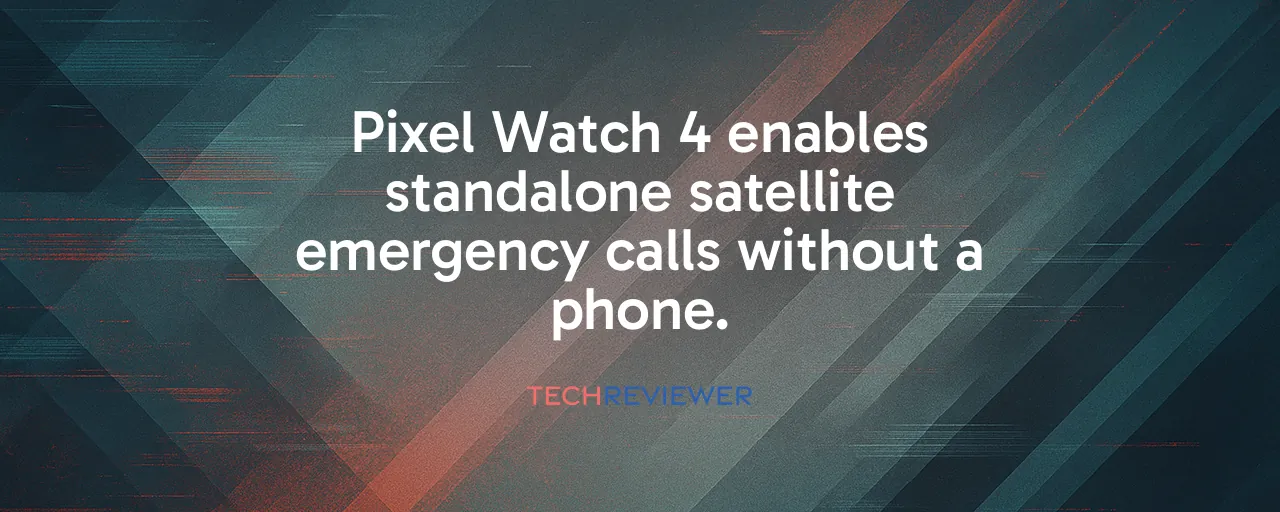A Smarter Watch for a Connected World
Google's Pixel Watch 4, launched in October 2025 for $349, arrives as a bold step forward for Android wearables. With a 40-hour battery life on its 45mm model and a brighter, curved display, it tackles the frustrations of earlier models head-on. What sets it apart, though, isn't just raw specs. The watch weaves in standalone satellite emergency communications, a first for any smartwatch, and a repairable design that lets users swap out batteries or screens. These features signal Google's ambition to not only compete with Samsung's Galaxy Watch 8 but also carve out a unique space in a market where Apple's dominance looms large.
The timing couldn't be better. With the global smartwatch market projected to hit $505.9 billion by 2035, growing at 19.5% annually, wearables are no longer niche gadgets. People want devices that last longer, do more, and feel personal. Google seems to get that, packing the Pixel Watch 4 with Gemini AI for conversational smarts and Fitbit's health tracking for wellness buffs. But it's not all smooth sailing, there are trade-offs, like subscription costs for premium features and limited third-party band options. Let's dive into what makes this watch tick and where it stumbles.
Fix It, Don't Toss It: A New Approach to Wearables
One of the Pixel Watch 4's biggest wins is its repairability, a rare feature in smartwatches. Partnering with iFixit, Google offers replacement batteries and displays, letting users extend the device's life with just a T2 Torx screwdriver. A WIRED teardown showed the process takes about 13 minutes, a stark contrast to the Apple Watch, where repairs often mean sending the device to Apple or buying a new one. This shift could change how we think about wearables, encouraging longer use over quick replacements. Studies suggest modular designs can extend device lifespans by 60-80%, a big deal in an industry churning out e-waste.
Take Sarah, a Pixel Watch 3 user who replaced her battery in early 2025 after it started fading. The process was straightforward, and she kept using her watch instead of upgrading. Compare that to an Apple Watch user, Mark, who faced a $200 repair bill for a cracked screen, pushing him to buy a new model instead. Google's approach isn't perfect, only batteries and displays are replaceable, and parts availability beyond two years is unclear, but it's a step toward sustainability that others might follow.
Safety on Your Wrist: Satellite SOS Steals the Show
The Pixel Watch 4's standalone satellite SOS feature came out of nowhere and could be a lifesaver. Unlike other smartwatches that rely on a paired phone, this one connects directly to geostationary satellites, letting users call for help in areas without cell service. Outdoor enthusiasts testing it in remote wilderness areas reached emergency services successfully, guided by the watch's alignment prompts. For hikers or trail runners, this adds real peace of mind, especially since it's the first smartwatch to pull this off without a phone.
There's a catch, though. The feature only works on the LTE model and is limited to the continental US for now, leaving international travelers or Alaskans out in the cold. Compare this to Garmin's inReach devices, which offer global satellite coverage but lack the Pixel's smartwatch versatility. Google's partnership with Garmin for emergency response infrastructure shows promise, but expanding coverage will be key to making this feature a must-have for adventurers worldwide.
AI and Health Tracking: Smarts Meet Wellness
On the software side, the Pixel Watch 4 leans hard into Google's Gemini AI, letting you ask questions or control apps conversationally from your wrist. Paired with Wear OS 6 and its Material 3 Expressive design, the interface feels cohesive, with colors adapting to your watch face for a polished look. Fitbit's health suite is the real draw for fitness fans, offering ECG, blood oxygen monitoring, stress detection, and automatic workout tracking. PCMag's tests confirmed the 45mm model lasts 56 hours with always-on display, blowing past Google's 40-hour claim and making it a reliable companion for weekend warriors.
But it's not all rosy. The 41mm model's real-world battery life of around 26 hours falls short of its 30-hour official rating, which may feel tight for power users, and advanced Fitbit features require a Premium subscription, adding costs. Samsung's Galaxy Watch 8, for instance, includes body composition analysis without extra fees, giving it an edge for some. Still, the Pixel's seamless integration with Google services like Maps and Calendar makes it a natural fit for Android users, especially those with Pixel phones.
Where It Fits in a Crowded Market
The Pixel Watch 4 lands in a fiercely competitive space. Samsung's Galaxy Watch 8 matches its $349 price and offers similar battery life, but its body composition tracking appeals to fitness buffs. Apple's Watch Series, starting at a higher price, dominates with a richer app ecosystem and tighter iOS integration. Google's play is ecosystem cohesion, pairing the watch with Pixel phones for seamless features like phone unlocking or remote camera control. But Android's fragmented phone market limits its reach compared to Apple's walled garden.
Privacy concerns also linger. Google's health data collection, while encrypted and not used for ads, raises eyebrows given its ad-driven business. Users wary of constant monitoring might hesitate, especially with the always-listening Gemini AI. Still, for Android loyalists, the Pixel Watch 4 delivers a compelling mix of smarts, safety, and sustainability. Its repairability and satellite SOS set a new bar, and if Google can expand the latter's coverage and keep parts available, it could redefine what we expect from wearables.
